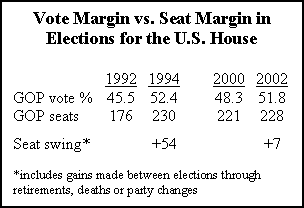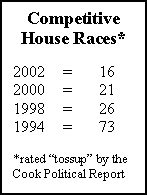
Mobilized by a president it holds in high regard, Republicans gave their winning House candidates wider margins of victory than in the past. This resulted in a significant gain in the party’s nationwide popular vote last Tuesday. But the GOP gained relatively few House seats, particularly when compared with the historic gains they made in 1994.
Preliminary totals show the Republicans with a 51.8%-45.2% advantage in the national House vote. This is on par with the GOP’s seven-point advantage in 1994 (52.4%-45.4%), an election that capped a 54-seat swing in the Republicans’ favor and gave the GOP a majority in that chamber for the first time in four decades.
The GOP fared very well this year, increasing its margin over the Democrats by 3.5% over the 2000 vote. That was less than half of the 6.9% change in the GOP’s favor between 1992 and 1994. The shift in the balance of power in the House in 1994 also was far greater than the rather modest shift that occurred last Tuesday.
Between 1992 and 1994, a 41-seat Democratic majority became a 13-seat Republican advantage – a 54-seat shift in the GOP’s favor. By contrast, on Nov. 5 Republicans gained just five seats (and a net gain of seven since 2000). Still, after three consecutive elections in which they lost seats, Republicans cemented their hold on the House and are now within two seats of their 1994 majority (228 now, 230 then).

Bigger Margins, Smaller Playing Field
Based on preliminary data provided by the Center for Voting and Democracy, the GOP’s lead in the popular vote served to widen the margin of victory for many GOP candidates. This data shows that the number of victorious Republican candidates who received at least 60% of the vote rose from 166 in 1998 to 186 in 2002. Among Democratic winners, landslide victories also are more common, but the increase has been smaller than among Republicans: 151 in 1998 to 161 in 2002.

Another key factor has to do with who voted and where. There were far fewer competitive House districts in 2002 than in 1994. In late October 1994, fully 73 House seats were rated as “tossups” by the Cook Political Report. In the 1998 election, Cook rated 26 seats in the tossup category. This number fell to 21 seats in 2000 and just 16 in the recently concluded election, which followed redistricting in 2001. As a result, the opportunity for either party to make major gains in seats has become more limited.

